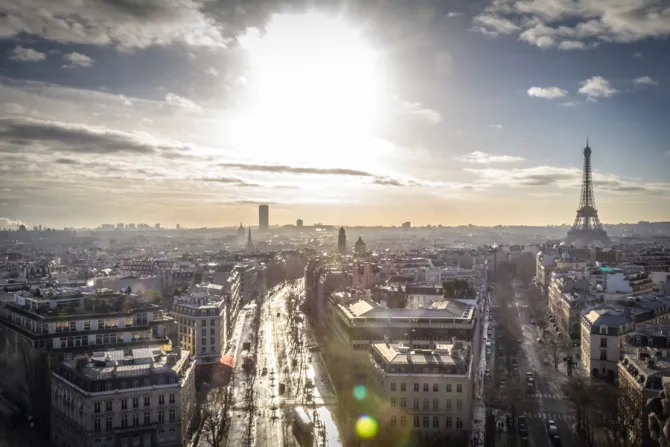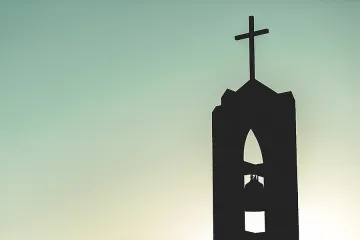Paris, France, Jul 11, 2019 / 18:01 pm
Vandalism, theft, arson and other increasing attacks on churches in France have led to debates about their causes, amid shock to the community, questions bout the perpetrators, and debates over what the attacks might mean about French culture and the place of Christianity.
"Those downplaying the vandalism, which include most leading newspapers and politicians, point to evidence that the attacks are the small-bore crimes of small-time miscreants. Those concerned that the attacks pose a more serious threat expressly dismiss that perspective," American journalist and author Richard Bernstein has said in an essay for RealClearInvestigations titled "Anti-Christian Attacks in France Quietly Quadrupled. Why?"
Bernstein sees merit in both perspectives, putting them in the context of pressing French questions about populism, national identity, immigration, tradition, authority, and power.
At the same time, he acknowledges the deep concern of Christian communities which suffer such attacks and vandalism, even when they are not "hate crimes" properly speaking.
"Still, even if many anti-Christian acts are not hate crimes intended to intimidate a community of believers, the fact is that there are a large number of attacks on Christian sites that are sacred to many people," he said. "Communities are shocked and made to feel vulnerable, in part by the sense that the incidents have proliferated so dramatically over the past few years, and they are taking place in virtually every corner of France: urban and rural areas, large towns and small villages alike."
The Conference of French Bishops said there were 228 "violent anti-Christian acts" from January to March 2019.
In 2018, French police reported 129 thefts and 877 incidents of vandalism at Catholic sites, mostly churches and cemeteries. The French Minister of the Interior counted slightly fewer numbers of anti-Christian incidents that year.
Such attacks quadrupled in number from 2008 to 2019.
While France has suffered more attacks than any other country in Europe, their numbers have increased across Europe.
Some leaders downplay the attacks.
"We do not want to develop a discourse of persecution," Archbishop Georges Pontier of Marseille, the head of the French Bishops Conference, told the magazine Le Point. "We do not wish to complain."
In June vandals toppled more than 100 tombstones in the main Catholic cemetery in Toulouse. The incident received little national press coverage, but locals too did not want to give it attention.
In Normandy in 2016, two men who professed allegiance to the Islamic State group murdered Father Jacques Hamel while he was celebrating Mass. That same year in Paris, police thwarted Muslim extremists who attempted to blow up a car near the Cathedral of Notre-Dame. Some feared anti-Christian sentiment was behind another Islamic State group sympathizer's gun and knife attack on a Christmas market in Strasbourg in 2018.
The backdrop of these and other major terrorist incidents have heightened fears that Christians would be more directly targeted.
The April 15 fire at the Cathedral of Notre-Dame shocked the world as the 19th-century roof and spire were destroyed, though the structure was saved from collapse.
As soon as the fire was reported, social media influencers and others with no presence on the scene spread speculation, rumors and even hoaxes claiming that the fire was an act of terrorism. Anonymous internet accounts as well as right-wing activists, nationalists, and white supremacists used the event to fan anti-Muslim sentiment, NBC News reported in April.
(Story continues below)
In June investigators said they had been unable to determine the cause and there was no evidence the fire was intentional. They said they would consider the possibility of negligence, including electrical malfunction or a poorly extinguished cigarette, as a cause for the fire.
Vandalism and attacks on Christian churches often appear to lack any organized coordination or shared motives.
Earlier this year, when six churches were set on fire or vandalized in one week, the perpetrators of one incident were two youths. The perpetrator in another was a 35-year-old homeless man.
Of identified perpetrators of anti-Christian attacks, more than 60 percent are minors. Many perpetrators "appear to be disaffected young people, or the psychologically disturbed or homeless, rather than members of organized groups advancing a political agenda," Bernstein said.
"Virtually none of the reported attacks have been against people; they are all against buildings, cemeteries or other physical objects," he added.
About 60% of vandalism incidents involved graffiti like satanic inscriptions, anarchist symbols, swastikas, or nationalist or neo-Nazi slogans. In Bernstein's view, this "would seem to represent a kind of ugly desperate social fringe than a general growth of anti-Christian hatred."
For Bernstein, the evidence shows attacks by Muslims "account for a small fraction of anti-Christian crimes."
The French government itself downplays anti-Christian actions for fear of stoking anti-Muslim reaction and retaliation, though there have not been any known incidents of retaliation.
While some commentators wonder why attacks on other groups draw more attention than attacks on Christians, Bernstein attributes this to the relative historical security of Catholics, especially in comparisons to Jews who were persecuted by French collaborators with Nazis in the Second World War.
Philosopher and cultural commentator Pierre Manent suggested that many churches are targets of opportunity, telling Bernstein, "This vandalism is drawn to Christian sites because they're less defended and present little risk, and there are a lot of them."
Church attendance has declined and the scandals about sexual abuse of young people and children by clergy make the Church "seem a weak and easy target," Bernstein said.
Jean-Francois Colosimo, a historian and theologian who is general director of the Editions du Cerf publishing house, said it is not "Christianophobia" but "a loss of the sense of the sacred" that is to blame.
Bernstein's essay cited an attack in the southwest France town of Lauvar. Two teenage boys sneaked into the town's 700-year-old Cathedral of St. Alain, set the altar on fire, turned a crucifix upside down, threw another crucifix into the nearby river, and deformed a statue of Christ.
Mayor of Lauvar Bernard Carayon told Bernstein the attack was far different than misbehavior like bathroom graffiti. He blamed "Christianophobia."
"The two boys who set fire to the altar and defaced the statue of Christ weren't just drunk; they carried out their attack purposefully, taking their time, and then, after they left to tell their friends what they'd done, they went back inside, no doubt to check the results," the mayor said, contending that the Catholic Church had wrongly prioritized inter-religious dialogue and working "to avoid conflict."
There has been vandalism and theft at the church, its pastor, Father Joseph Dequick said, but the police do not distinguish which is which. This means it is difficult to distinguish criminal theft from vandalism based in hostility to the Church.
"But when somebody turns a cross upside down, that's an anti-Christian expression," he said. "That represents a society that no longer transmits respect for values. It's a loss of the sense of the sacred. It's consumerism. Young people can do whatever they want now, have whatever they want. Where are the limits? Where are the parents?"
According to the priest, professions of atheism are fashionable and there is "a mood against the Church, against faith"
"The media are anti-Catholic. There a discourse against the Church. In France, in particular, there's an anti-clerical feeling that goes back a long time," the priest told Bernstein. "It's not so much a religious argument as a political one. It's a reaction against the moral limitations that the Church represents."
Manent told Bernstein there is a cultural attitude that the Church is "an obstacle to contemporary life," and this attitude "nourishes a certain hostility."




